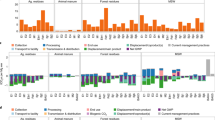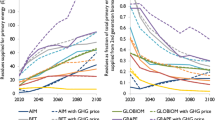Abstract
The National Energy Modeling System (NEMS) is used by the Energy Information Administration (EIA) to forecast US energy production, consumption, and price trends for a 25-yr-time horizon. Biomass is one of the technologies within NEMS, which plays a key role in several scenarios. An endogenously determined biomass supply schedule is used to derive the price-quantity relationship of biomass. There are four components to the NEMS biomass supply schedule including: agricultural residues, energy crops, forestry residues, and urban wood waste/mill residues. The EIA'S Annual Energy Outlook 2005 includes updated estimates of the agricultural residue portion of the biomass supply schedule. The changes from previous agricultural residue supply estimates include: revised assumptions concerning corn stover and wheat straw residue availabilities, inclusion of non-corn and non-wheat agricultural residues (such as barley, rice straw, and sugarcane bagasse), and the implementation of assumptions concerning increases in no-till farming. This article will discuss the impact of these changes on the supply schedule.
Similar content being viewed by others
References
Walsh, M., Perlack, R. Turhollow, A., et al. (2000), Biomass Feedstock Availability in the United States: 1999 State Level Analysis, http://bioenergy.ornl.gov/resourcedata/index.html.
Antares Group, Inc. (1999), Biomass Residue Supply Curves for the United States (Update), Report for the U.S. Department of Energy and the National Renewable Energy Laboratory.
U.S. Department of Agriculture (2004), National Agricultural Statistical Service (NASS), Agricultural Statistics Data Base, http://www.nass.usda.gov.
Energy Information Administration (2005), Annual Energy Outlook 2005 With Projections to 2025, http://www.eia.doe. gov/oiaf/aeo/index.html.
Conservation Technology Information Center (2004), Percentage No-Till Acres by Crop 2002, http://www.ctic.purdue.edu/CTIC/PercentChart.html.
Hassell, J. (2001), Conservation Technology Information Center, National Association of Conservation Districts, Statement to the Senate Committee on Agriculture, Nutrition and Forestry, relative to conservation programs in the Farm Bill, http://www.ctic.purdue.edu/core4/Testimoyy.html.
Graham, R., Nelson, R., Tharp, L., et al. (2004), Estimating the U.S. Corn Stover Supply: A Review of Methods & Results, Oct. 9, 2003 presentation to DOE & USDA, and July 2004 update (e-mail with spreadsheet).
U.S. Department of Energy, Biomass Program (2003), Roadmap for Agricultural Biomass Feedstock Supply in the United States, http://www.bioproducts-bioenergy.gov/pdf/Ag_Roadmap.pdf.
Turhollow, A. and Sokhansanj, S. (2006), Costs of Harvesting, Storing, and Transporting Corn Stover in Wet Form, final draft, Appl. Eng. Agri. J., in press.
Schechinger, T. and Hettenhaus, J. (2004), Corn Stover Harvesting: Grower, Custom Operator, and Processor Issues and Answers—Report on Corn Stover Harvest Experiences in Iowa and Wisconsin for the 1997–98 and 1998–99 Crop Years, Oak Ridge National Laboratory.
Gallagher, P., Dikeman, M., Fritz, J. Wailes, E., Gauther, W., and Shapouri, H. (2003), Biomass From Crop Residues: Cost and Supply Estimates, published by the USDA Office of Energy Policy and New Uses, Agricultural Economic Report No. 819.
California Energy Commission (CEC), Prepared by Von Bernath, H., Jenkins, B., et al. (2004), An Assessment of Biomass Resources in California.
Holt, G. and Funk, P. (August 8, 2004), Southwestern Cotton Ginning Research Laboratory, USDA Agricultural Research Service, personal communication.
Sokhansanj, S., Turhollow, A., and Perlack, R. (2002), Stochastic Modeling of Costs of Corn Stover Costs Delivered to an Intermediate Storage Facility, American Society of Agricultural Engineers, Annual International Meeting/CIGR XVth World Congress, Chicago, IL.
Atchison, J. and Hettenhaus, J. (2003), Innovative Methods for Corn Stover Collecting, Handling, Storing and Transporting, prepared for the National Renewable Energy Laboratory.
Turhollow, A. (2004), Personal communication, August 11, 2004.
Sokhansanj, S. and Turhollow, A. (July 2004), Biomass Densification-Cubing Operations and Costs for Corn Stover, Appl. Eng. Agri. J. 20(4), 495–499.
Miller, D., and Rotz, A. (1995), In: Barnes, Robert F. Miller, Darrell, A., and Jerry Nelson, C. (eds.) Harvesting and Storage. Forages 5th ed., Vol I An Introduction to Grassland Science, Iowa State University Press, Ames, IA, pp. 163–174.
Miles, T. (2004), Gasifier Suitability Analysis: Selection of Gasification Systems for BERC Demonstration/Commercialization, Final Report, for the Biomass Energy Resource Center.
Author information
Authors and Affiliations
Corresponding author
Rights and permissions
About this article
Cite this article
Haq, Z., Easterly, J.L. Agricultural residue availability in the United States. Appl Biochem Biotechnol 129, 3–21 (2006). https://doi.org/10.1385/ABAB:129:1:3
Issue Date:
DOI: https://doi.org/10.1385/ABAB:129:1:3




